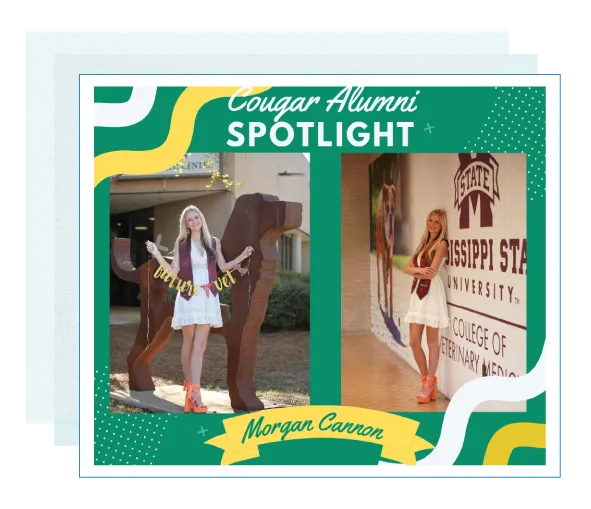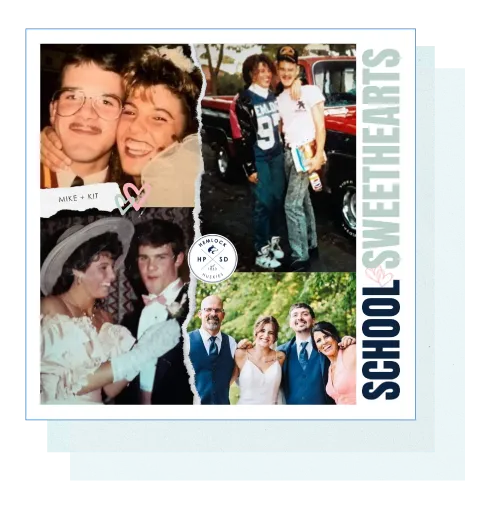Are Your Alumni All In?
Alumni engagement strategies for inviting former students "back to school" and why it could benefit your district to take some notes


ARE YOUR
ALUMNI ALL IN?
How alumni engagement can
help your schools succeed
For so many of us, high school was filled with emotionally charged firsts—learning to drive, going on dates, applying to college, registering to vote and so on. These moments tend to loom large in our memories and keep us connected to the schools that cocooned us during such a transformative time in our lives.
Since their inception, universities and private schools have recognized the value of that connection and sought to maintain it by keeping former students engaged. They also have considerably more resources than public schools; many have paid staff members who specialize in alumni engagement, to start. But many public schools are already making a concerted effort to bring alumni back into the fold. In this article, we’ll look at ways different institutions have invited their alumni “back to school,” and why it could benefit your district to take some notes.
Successful Alumni Engagement Strategies
Saying you need to engage alumni is all well and good, but where do you even start? Here are a few alumni engagement ideas you can use to connect with former students in your districts.
Keep in touch.
You can’t reach out to your alumni if you don’t have their contact information. And the easiest way to keep track of former students is to make it easy for them to provide that info.
In addition to the usual categories like “Athletics” and “Academics,” the website for Mississippi private school Central Hinds Academy includes an “Alumni” tab, which links to a page full of alumni spotlights and event announcements. It’s an easy-to-find hub for Central Hinds graduates to see news related to them. At the very top of the alumni page is a button visitors can click to “Update My Alumni Information.” Making it easy for alumni to “opt in” is the gentlest and most effective way to build a contact list.
Brandy Cannon, a kindergarten teacher at Central Hinds, volunteered to become the school’s point person for alumni communications last year. Although she’s not an alum herself, both of her children attended the school. Cannon writes articles for the alumni webpage and posts them to the school’s Facebook and Instagram. At the end of every post, she directs her audience back to the alumni page to update their contact information.
While her audience started out small, Cannon has remained consistent with her posts. Friends and followers of Central Hinds have come to expect alumni posts in their feeds, and Cannon is gaining new “friends” all the time. “I do one post a week that is alumni-centric. I will get three, five, seven people adding their contact information to our database with each one,” she says.

Pamela Owen, former associate vice president for alumni and constituent engagement at Arkansas’ Hendrix College, used LinkedIn to engage the school’s alumni. From the college’s profile, Owen reposted news releases from the small liberal arts school to keep students up to date on their alma mater. But Owen didn’t just wait for alumni to come to her—she also searched for alumni who listed Hendrix College on their profiles and invited them to connect on the website. The Hendrix alumni group she started now has close to 2,000 connections. Connecting with alumni on LinkedIn also gave Owen an opportunity to track former students’ career developments and congratulate them on their successes.
Once you have collected a sizable number of email addresses by engaging alumni online, consider taking it one step further by sending an e-newsletter to your contact list. Even if you can only send one or two newsletters per year, it’s another way to remind them that even though they no longer attend your school, you still consider them a part of your school community.
Tell a good story.
At Hemlock Public School District in Michigan, District Communications Specialist Joy McMillan has come up with several creative alumni engagement ideas to keep former Huskies connected to their alma mater.
McMillan had already launched an alumni spotlight on the district website and social media during the school year. But when she heard that several married couples in her community had met at Hemlock High School, McMillan jumped at the chance to highlight the district’s role in those love stories. Each week during the month of February, she shared a “School Sweethearts” post featuring a couple who met and fell in love in Hemlock schools—one had been married 10 years, another over 50—with a story about their romance and a photo collage of the couple.
McMillan believes in the power of a good story, and the “School Sweethearts” series delivered a string of happily ever afters. “There’s so much ugly news out there,” she says. “It was an opportunity not just to celebrate our alumni, but to celebrate commitment—to celebrate the love stories that started in the halls of our schools.” The series was a hit. “I would read through the comments, and people would tag other families or couples and say, ‘Oh, my goodness! You guys should do this!’” McMillan says. “So I already know I have plenty for next year.”
With the success of the “School Sweethearts” campaign and the school year coming to a close, McMillan thought up another series featuring former Hemlock students to run during summer break. “‘Humans of Hemlock’ was inspired by Humans of New York. It was a way of casting that net even wider,” she says. If you’re not familiar with Humans of New York, the popular blog features professional photos of everyday New Yorkers—people you might pass on the street—captioned with a story from their life, in their own words.

“I just thought, I’ve done an alumni spotlight and I’ve done the ‘Sweetheart’ spotlight—so how do we keep it going?” McMillan says. Many of the people she featured were alumni, such as Hemlock’s chief of police. Others were stalwarts of the community—like Carol, an 84-year-old woman with a collection of over 250 orchids in her greenhouse behind one of the district’s schools. “Carol bakes for our custodians, and everybody knows her. But not everyone knows her story,” McMillan says.
“The beautiful thing about spotlighting people—not just current students, but previous students or even community members—is that they share it with their family members and their family members share it. So it continues to widen that net,” McMillan says.
Show them you care.
Which leads us to our next point—alumni engagement shouldn’t be a blatant money grab. You’re much more likely to engage former students if you express a genuine interest in them and offer them something of value. Think back to Cannon’s successful “Update My Alumni Information” button. Her success is not due solely to her social media presence. Her alumni are sharing their contact information because she’s offering something in return.
One service Cannon provides to former Central Hinds students is visibility. “We put out an alumni directory that includes their business name and contact information if they so choose—just to let people know who’s around and what they’re up to,” she says. “They can use that as an advertisement.” Adding a list of alumni-owned businesses to your website or promoting them in your newsletter shows pride in what they’ve accomplished and gives them a chance to connect with one another.

To show Hendrix alumni that their school still cares about them, Owen’s former office sends a note of congratulations every time they learn of a job promotion through LinkedIn. “We do something that’s called ‘Hendrix Peeps.’ We buy Peeps candy and send it with a little postcard that says, ‘Congratulations on your new promotion from your Hendrix peeps,’” she explains. “It sounds kind of hokey, but at the same time it’s a connection. We see you and we’re proud of you.”
When you become aware of other big changes in an alum’s life, these are opportunities to reach out and congratulate them. “Acknowledge them and what they’ve accomplished. It’s amazing how people respond to that,” Owen says.
Like McMillan at Hemlock, Cannon’s alumni spotlights acknowledge the achievements of Central Hinds graduates. “For example, the next one I’m working on is a young man who just finished basic training with the Coast Guard,” Cannon says. She regularly posts features about former high school athletes who are playing at the next level—in college and beyond. Alumni can submit nominations for spotlights on the website.
“The things that have gotten the most response are usually our young alumni that are just starting their careers. We love to see our kids doing well and to be able to say, ‘That kid came from Central Hinds, and she’s doing big things,’” Cannon says. This year, she has begun writing big send-offs for her graduating students. “We’re trying to get our students involved as alumni before they even leave by doing senior spotlights with their plans for the future—so that as they graduate, they already see the value in staying connected,” she says.
Why Alumni Engagement Matters
When most people think of alumni engagement, they think of schools hitting up former students for donations. While financial gain is certainly one potential benefit, it should not be your whole focus.
You need volunteers.
“Your volunteers are your backbone, and you really can’t do your job without them,” says Owen. Public schools are in constant need of more hands on deck—in classrooms, in the central office or at events. If you’re looking for an assistant volleyball coach or club sponsor, ask yourself: Are we ignoring a huge potential resource by not better engaging our alumni?
At Hendrix, Owen recruited volunteers to help the admissions office call prospective students. After all, alumni are excellent spokespeople for your schools. No one knows what it’s like to be a student at your school better than a former student. Likewise, alumni can offer your current and prospective students a peek into what their lives might look like after graduation.
When possible, appeal to specific groups of people within your wider alumni base; don’t treat them like a monolith. Students who were politically active before they could vote will likely still be active members of their political parties, so ask them to speak at a political club or to student government. If you’re engaging with a former choir member, don’t just ask them to volunteer—ask them to help with the next concert.
Yes, you need financial support.
This one is obvious because it’s necessary. Smart alumni programs know that financial support is only one of the many benefits of a robust alumni engagement program. Having said that, public schools almost always lack proper funding. Alumni are an enormous source of income for private schools and universities, and while public schools don’t operate the same way, small donations matter.
Those alumni who are unable to donate cash may still be willing to provide financial assistance in other ways. Former students who own businesses might be interested in sponsoring a sports team or offering discounts to staff, and engaged alumni who still live nearby are more likely to show up at the polls when you need to pass a bond.
But a fundamental principle of fundraising is that engagement has to come first. Alumni engagement is no different. “You need to build a relationship before you swoop in and ask someone for a cash gift,” Owen warns. Owen says she never asked for money the first time one of their alumni attended an event on campus or offered to volunteer because that is a big commitment in itself. “Be grateful for everything your alumni give you because their time is the greatest commodity,” she tells us.
Your students will gain the biggest benefit.
In the end, the top priority for schools is to provide the best possible outcomes for their students. “That’s how my daughter got her first job at a veterinary clinic. A teacher called an alum and said, ‘We’ve got a Cougar kid hoping to go to vet school. Have you got anything you could do to help her out?’” Cannon says.
Owen agrees that networking and career guidance are some of the biggest benefits of a robust alumni engagement program. “We have a large number of students that go to medical school, and we have a shadowing program with doctors during the summertime,” she says. “That gives students an opportunity to get an idea of what it’s actually like working with patients and being in a hospital or clinic environment.”
Matching students’ career interests with alumni who work in those fields actually benefits both parties. Mentees gain valuable insights into potential careers and make important contacts in those industries, while mentors meet students they can someday recruit to become interns and employees. And alumni don’t just have the potential to make a positive impact on students’ academic careers; at Central Hinds they have actually been able to contribute to current students’ health. Every year, a local dentist and a local optometrist—both alumni—visit the school and offer free screenings.
You need to attract new students.
If we’ve said it once, we’ve said it a million times: K-12 is facing unprecedented competition for students and staff. “We’re in the middle of nowhere. We’ve got a cow pasture on one side and woods on the other side,” Cannon says about Central Hinds Academy. It’s just one more reason why showing off their former students makes so much sense. “It’s an advertisement for parents who are thinking about sending their kids here,” she says. “We’re not just some little rural school—we’re a school that’s putting quality people out into the world.” Cannon is right. Plus, satisfied alumni are much more likely to send their children to your schools.
Although public schools like Hemlock don’t have the same resources as private institutions like Central Hinds Academy or Hendrix College, Cannon says public schools do have one advantage when it comes to alumni engagement. “Sometimes I have to really search out people to spotlight. Public schools usually have a larger pool to draw from,” she says. “I think any school can build a sense of community and let their alumni know that they are still important even though they’ve graduated. That’s possible for any school to do.”


